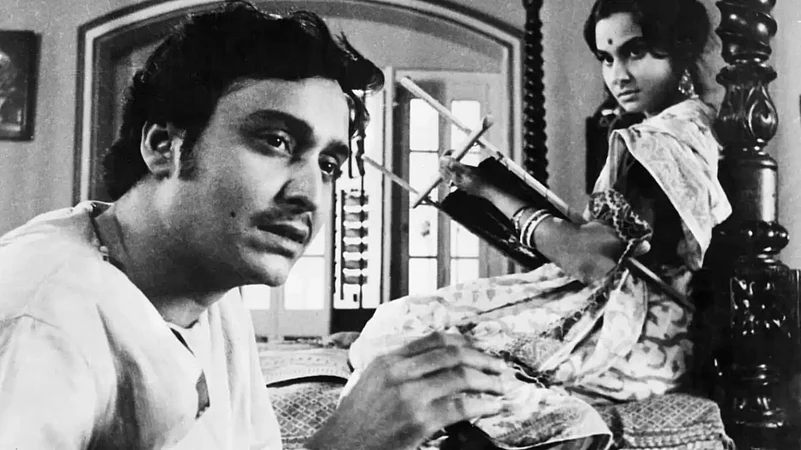Title: Soumitra Chatterjee: His Life in Cinema and Beyond
Author: Amitava Nag
Publisher: Speaking Tiger
Pages: 210
Price: Rs 499
Cinema lovers around the world would probably recognise Soumitra Chatterjee as Apu, the protagonist of Satyajit Ray-directed Apur Sansar (The World of Apu, 1959). They might even remember him as Amal, the dreamy-eyed poet in Charulata (The Lonely Wife, 1964), or the beleaguered Brahmin Gangacharan in Ashani Sanket (Distant Thunder, 1973), or the wily Sandip in Ghare Baire (The Home and the World, 1984). Children in Bengal probably still recognise him as Feluda, the sleuth who is as adept at using his Colt 69 as his mogojastro (brain weapon). Chatterjee acted in 14 of Ray’s films and their association has often been compared to that of Ingmar Bergman and Max von Sydow, and Federico Fellini and Marcello Mastroianni. But he also had a much wider career in cinema.
Independent film critic Amitava Nag writes in his biography of Chatterjee that in the 1960s, he was the first choice for both Ray and Mrinal Sen, two of the leading art house directors of Bengali cinema. Only Ritwik Ghatak never used Chatterjee. However, Chatterjee also worked successfully in films of other directors such as Tapan Sinha, Ajoy Kar, Ashutosh Bandyopadhyay, and Nityananda Dutta. He was the cunning Mayurbahan in Jhinder Bondi (1961), the terrorised schoolteacher in Atanka (1986), and the passionate swimming coach in Kony (1984), emerging as not only a successful leading man in both mainstream and offbeat Bengali cinema but also a competitor and foil to its reigning superstar Uttam Kumar. When Chatterjee died at the age of 85 years on 15 November 2020, succumbing to post-Covid complications, he was still working on at least 10 films.
Besides cinema, Chatterjee was also successful on the stage — acting and directing both original plays as well as adaptations. People in Kolkata would probably still remember his remarkable performance as King Lear in a Bengali adaptation of the play nearly 10 years ago. I remember standing in the aisle of Minerva theatre in north Kolkata and admiring his performance to a houseful audience — a rarity for most staged performances in the city. Chatterjee also wrote poetry, published several books, co-edited the well-regarded literary magazine Ekshan, and also dabbled in art. Nag’s biography brings out all these different aspects of his personality.
There is perhaps hardly anyone better equipped to write this book. Nag is a well-known commentator on Bengali cinema and has previously written on the films of Ray, Chatterjee’s oeuvre beyond Ray’s films, and a biography of Tapan Sinha. He has also translated Chatterjee’s poetry from Bengali to English. Nag has had a long personal association with Chatterjee, the kind of access one can only dream of having with a leading film personality. “In our shared spaces in the evenings and mornings, he would tell me stories of his early days,” writes Nag. “I had a lot of questions, now informally. There were no recorders that intruded on our privacy and made him conscious and reserved.” The result of this is the empathy with which he narrates and interprets various aspects of Chatterjee’s career and life.
However, the book would have benefitted from a more rigorous methodology. A look at the bibliography reveals that Nag has consulted mostly books written by Chatterjee and a few others. There is hardly any investigation involving archives of newspapers and magazines that would have revealed the contemporary reception of Chatterjee’s films, plays, and books. Or his correspondence. There are no interviews with any of his colleagues or his family. These are absolutely essential components of a contemporary biography. They also provide context and allow the biographer to interpret or contextualize the events in their subject’s life.
The book under review, in fact, shines when it does this kind of archival work. For instance, in chapter four, A Golden Streak, where Nag explores Chatterjee’s work as the co-editor of his magazine Ekshan, he writes about how it published the writing of 19th-century actresses of the Bengali stage, such as Binodini Dasi, Prasannamayi Devi, Manada Devi, Jnanadanandini Devi, and others. At a time when public performances, especially by women, were looked down upon by the polite bhadralok society of Kolkata, the work of many of these women was lost in the archives. The work done by Chatterjee and his co-editors to rescue and annotate them even inspired Ray to create the scenes of Charulata.
Similarly, the sections of the book where Nag provides a glimpse of the labour problems that plagued the Bengali film industry in the late-1960s are very important scholarship. In recent decades, scholarship on Indian cinema —both academic and journalistic— has grown significantly, though much of it continues to focus on Bollywood. Scholarship in Bengali cinema has rarely emerged out of its focus on the trinity of Ray, Sen, and Ghatak, and more recently, Rituparno Ghosh. A few exceptions to this general trend are Bengali Cinema: An Other Nation by Sharmistha Gooptu, a recent biography of Uttam Kumar by Sayandeb Chowdhury, or Maitreyee Chowdhury’s Bengali Cinema’s First Couple. Nag’s biography of Chatterjee will not only add to this body of literature but also, hopefully, encourage other researchers to explore this fertile area.
(Uttaran Das Gupta is a New Delhi-based writer and journalist. He teaches journalism at O P Jindal Global University, Sonipat.)
















